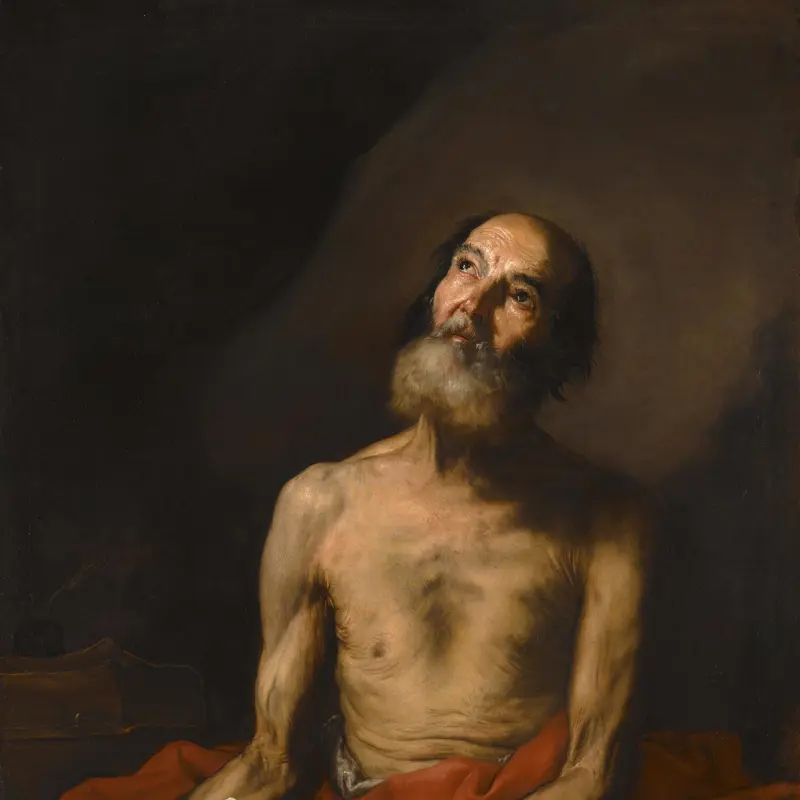Jusepe de Ribera, 'The Lamentation over the Dead Christ', early 1620s
About the work
Overview
Ribera captures the moment when Christ’s lifeless body is laid out after it has been brought down from the Cross. A solemn Saint John the Evangelist, dressed in red and green, gently supports Christ’s elegant corpse. Christ’s pallor is striking – his lips and skin are turning grey-blue – and his brow is smeared with the blood he shed from wearing the crown of thorns. In the centre of the composition is the Virgin Mary, joining her hands in prayer and looking down at her son in extreme sorrow. Mary Magdalene bends over and brings her face close to Christ’s feet, as if about to kiss the wounds caused by the nails that held him to the Cross.
This is a youthful work by Ribera, and his earliest representation of the subject. Ribera studied the works of Caravaggio and these were to have a lasting influence on his style – here the naturalistic body of Christ and dramatic use of light are both inspired by him.
Key facts
Details
- Full title
- The Lamentation over the Dead Christ
- Artist
- Jusepe de Ribera
- Artist dates
- 1591 - 1652
- Date made
- Early 1620s
- Medium and support
- Oil on canvas
- Dimensions
- 129.5 × 181 cm
- Acquisition credit
- Presented by David Barclay, 1853
- Inventory number
- NG235
- Location
- Room 30
- Collection
- Main Collection
- Previous owners
- Frame
- 17th-century Italian Frame
Provenance
Additional information
Text extracted from the ‘Provenance’ section of the catalogue entry in Neil MacLaren, revised by Allan Braham, ‘National Gallery Catalogues: The Spanish School’, London 1988; for further information, see the full catalogue entry.
Exhibition history
-
2009The Sacred Made Real: Spanish Painting and Sculpture 1600–1700The National Gallery (London)21 October 2009 - 24 January 2010National Gallery of Art (Washington DC)28 February 2010 - 31 May 2010Museo Nacional de Escultura28 June 2010 - 17 October 2010
-
2011The Young RiberaMuseo Nacional del Prado5 April 2011 - 28 August 2011Museo Nazionale di Capodimonte23 September 2011 - 8 January 2012
-
2016Beyond CaravaggioThe National Gallery (London)12 October 2016 - 15 January 2017National Gallery of Ireland11 February 2017 - 14 May 2017Scottish National Gallery17 June 2017 - 24 September 2017
-
2024Ribera: Shadows and LightPetit Palais, Musée des Beaux Arts de la Ville de Paris5 November 2024 - 23 February 2025
Bibliography
-
1946R. Mesuret, 'Un tableau de Tournier à la National Gallery', Revue historique et littéraire du Languedoc, X, 1946, pp. 137-43
-
1952Maclaren, Neil, National Gallery Catalogues: The Spanish School, London 1952
-
1957R. Mesuret, 'L'Oeuvre peint de Nicolas Tournier: Essai de catalogue', Gazette des beaux-arts, XCIX/2, 1957, pp. 327-50
-
1958J.A. Gaya Nuño, La pintura española fuera de España: Historia y catálogo, Madrid 1958
-
1970N. MacLaren and A. Braham, The Spanish School, 2nd edn, London 1970
-
1971C.M. Felton, Jusepe de Ribera: A Catalogue Raisonné, Ann Arbor 1971
-
1978N. Spinosa and A.E. Pérez Sánchez, L'opera completa del Ribera, Milan 1978
-
1988Maclaren, Neil, revised by Allan Braham, National Gallery Catalogues: The Spanish School, 2nd edn (revised), London 1988
-
1990E. Nappi, 'Un regesto di documenti editi ed inediti, tratti prevalentemente dall'Archivio Storico del Banco di Napoli, riguardanti Giuseppe Ribera e una conferma della presenza a Napoli nel novembre 1630 di Velázquez', Ricerche sul '600 napoletano, IX, 1990, pp. 177-86
-
1991F. Bologna, Battistello Caracciolo e il primo naturalismo a Napoli (exh. cat. Chiesa della Certosa di San Martino, 9 November 1991 - 19 January 1992), Naples 1991
-
1992N. Spinosa, 'Ribera a Napoli', in N. Spinosa and A.E. Pérez Sánchez (eds), Jusepe de Ribera 1591-1652, Naples 1992, pp. 30-55
-
2001
C. Baker and T. Henry, The National Gallery: Complete Illustrated Catalogue, London 2001
-
2003N. Spinosa, Ribera, Naples 2003
-
2003G. Finaldi, Ribera: La Piedad (exh. cat. Museo Nacional Thyssen-Bornemisza, 20 February - 11 May 2003), Madrid 2003
-
2005V. Sgarbi et al., Caravaggio e l'Europa: Il movimento caravaggesco internazionale da Caravaggio a Mattia Preti (exh. cat. Palazzo Reale (Milan), 15 October 2005 - 6 February 2006), Milan 2005
-
2008N. Spinosa, Ribera: La obra completa, Madrid 2008
-
2009X. Bray et al., The Sacred Made Real: Spanish Painting and Sculpture, 1600-1700 (exh. cat., The National Gallery, London; National Gallery of Art, Washington), London 2009
-
2009D. Carr, El Greco to Goya: Spanish Painting, London 2009
About this record
If you know more about this work or have spotted an error, please contact us. Please note that exhibition histories are listed from 2009 onwards. Bibliographies may not be complete; more comprehensive information is available in the National Gallery Library.



